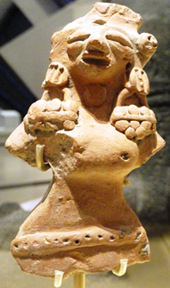|
Musings:
What happened to godesses?
by Padma Edirisinghe
In a manuscript I am contemplating to translate there is a surfeit of
female goddesses. The main ones are Mother Goddess also known as Jagath
Maatha, Goddess Adithi or Earth, Durga, Lakshmi, Saraswathie, Kali,
Marichi, Tharra, Vajravarani. Their zone is the cavern of history in the
east, i.e. the Harappa and the Mohendajaro civilisations belonging to
that far-off time epoch ranging according to different historians from
3250 to 2750 BC, 2500 to 1500 BC and 2500 to 1500 BC.
|

Indus Valley Figurines
|

Female figure, possibly a fertility goddess, Harappan
Phase, BCE. 2500-1900 Pic. Wikipedia |
The issue, however, is not the time but as to what happened to these
revered females in subsequent times? Obviously most of them have toppled
and in their mother country itself out of all places. It is an irony
that the country noted for the pedestals of these goddesses has now
turned into a sordid venue of the most brutal torments on women as in
the tragedy of the medical student some years back.
Movements
Despite many an accolade heaped on measures taken to make the woman a
more active member in our society that they continue to take a back seat
is evident. Very few or in most instances there are no women who pioneer
national movements, be they the major ones in the world as the
renaissance and the reformation, or myriad national movements in each
nation state.
That this state of affairs could be ascribed to the notion that the
woman's real duties are child bearing and child rearing, cannot be
overlooked.
But perusing the conditions embroiled with the emancipation of
females in the Indus valley the later developments veering towards the
demeaning of the woman invite only amazement. Lasses have been equally
educated as the lads.
They were known as Kathee and the dormitories allotted to them have
also been named as Jaathisaala. The women composed hymns and suttas and
studied Vedas.
There were no child marriages and no Sathi poojas where the woman
immolated herself in the burning fires of the pyre of the dead husband.
The widow could marry again and even beget children. Educated women
debated with learned men sometimes defeating them by their sheer
oratory.
Times
Then came dark times for the female kind. Not only in the east but in
the West too, known as the bedrock of liberty. Of course the West had
not boasted such a glorious period of female emancipation as the Indus
valley. But no one can deny that they continued to lag. Not even one
female name seems to adorn the list of those who piloted at the highest
level the great movements of the French revolution and the American
revolution.
One can rest in the consolation however, that all those heroic
figures who achieved the utmost in the progress of the world were
begotten by females and then reared by females.
Here, the above text makes an interesting point explaining the spurt
of recognition that the female of the Indus valley received.
That was that due to the non advancement of scientific knowledge in
these terrains, that the father had his share in the procreation process
was not known. Hence the mother was the sole participant in the
reproductive process! Perhaps that explains the glorious term Jagath
Maatha.
|

